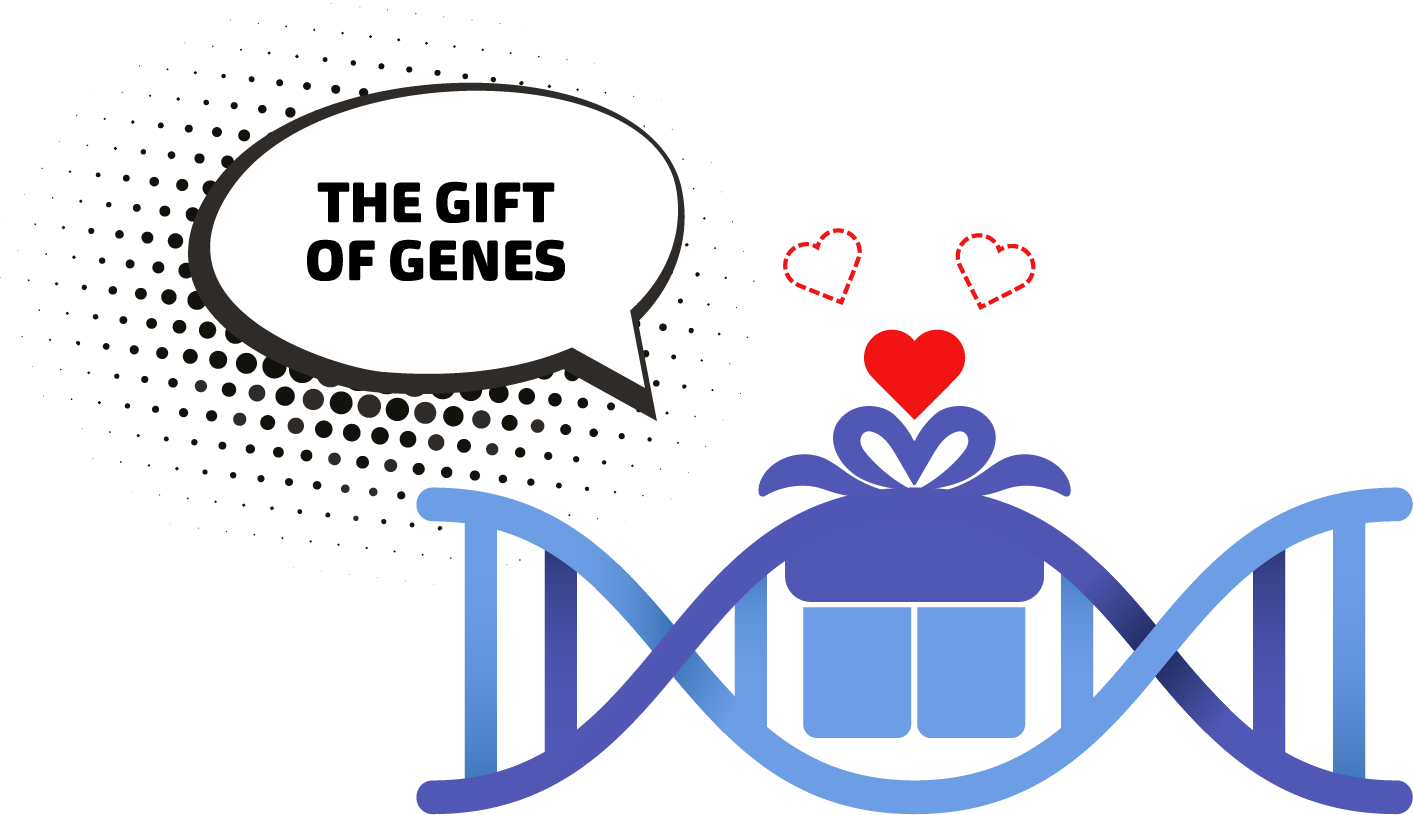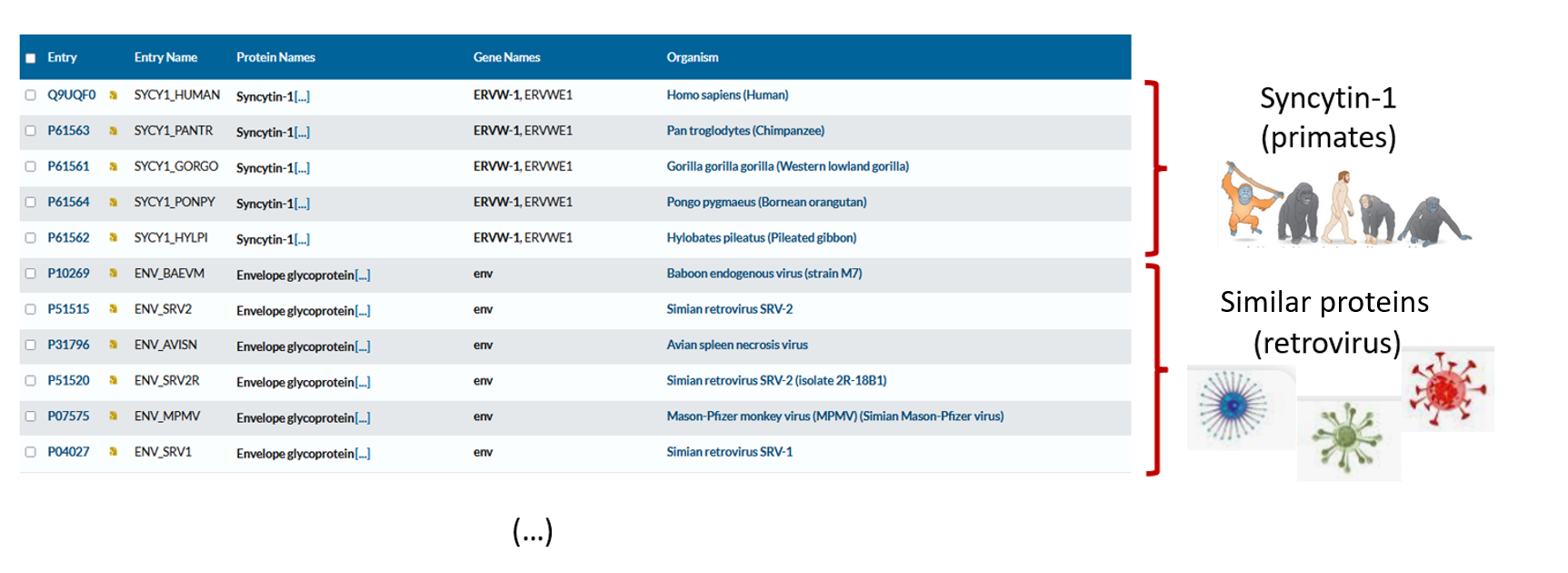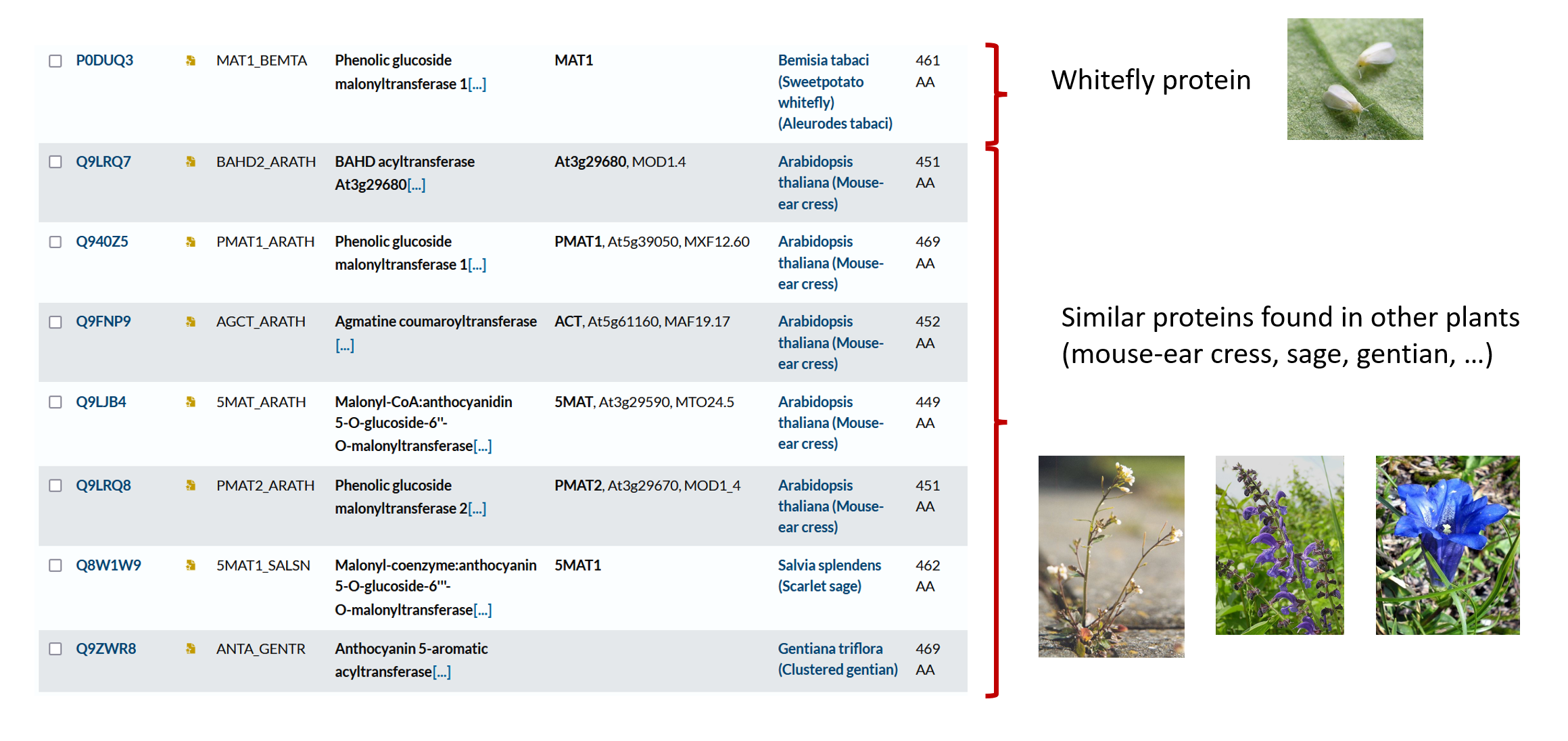Duration of the activity: 30 minutes
Recommended age: 15 years old and onwards
Comparative genomicsQuest for orthologs
The Gift of Genes
– Your turn to play
Sushi, baby bottle and vegetarian menu

Context
Horizontal Gene Transfer (HGT) plays an important role in the evolution of organisms.
What is it ?
In horizontal gene transfer, an organism incorporates DNA from another unrelated organism into its own DNA.
Why is it important?
Genes which are “gifted” from one species to another are useful because they give new functions or traits which were not present before. This ultimately helps the organism adapt to its environment.
For example, many bacteria acquire antibiotic resistance genes through HGT. Some insects steal genes from their favourite plant to counter-attack plant defense mechanisms. Even viruses can transfer their genes, and this has shaped mammalian evolution – approximately 8% of the human genome is of viral origin (see below)!
Horizontal gene transfer might have even played a key role in the origin of sex ( Go back to ‘The Gift of Genes – Story’).
The Japanese and sushi: a story about bacteria
Horizontal transfer: marine bacteria – terrestrial bacteria
The Japanese eat an average of 14 grams of seaweed per day, including the red algae that surrounds some sushi.
These algae contain complex sugars that only the Japanese can digest: why?
Our intestines contain some 10,000 billion bacteria: this is called the intestinal microbiota. These bacteria actively participate in the digestion of food and, in particular, in the digestion of complex sugars which are an important source of energy.
The Japanese are the only people to possess an intestinal bacterium called B. plebeius. This bacterium has ‘stolen’ several genes from Z. galactanivorans, a marine bacterium found on red algae. And these genes allow B. plebeius to digest the complex sugars present in the red algae that surround sushi!
Result: the Japanese are the only ones who digest sushi properly!
The intestinal microbiota of the Japanese has thus adapted to the presence of complex sugars found in sushi and is able to digest them thanks to (1) the presence of the bacterium B. plebeius and (2) the horizontal transfer of genes (and skills) between marine bacteria (Z. galactanivorans) and terrestrial bacteria (B. plebeius)…
Your turn to play
Here is the amino acid sequence of the protein encoded by the PorB gene of B. plebeius. This protein allows the Japanese to digest the complex sugars found in the algae of sushi.
>sp|B5CY92|P.plebeius MRKTVLYLSAASLFLSSYTLKNDKEYSLAEEHIKNLPEAPEGYKWVVNEDYTDEFNGKRL NAAKWHAKSPYWTNGRPPATFKAENVSVKKGCLRIINTVLSPTEGLDGKPGDKYRLAGGA VASVKNQAHYGYYETRMKASLTTMSSTFWLSNRPVMKEIMKGGKKIKTWSSQELDIIETM GIIRSVNPDNPWNKTWNMQMNSNTHYWYQEQGGKRTDNTAKRSDVVSYMTDPSAEDFHTY GCWWVDANTVKFYYDGKYMYTIKPTTKYTDTPFDRPMFIHIVTETYDWEKQVPTAEDLKD KDKSTTYYDWVRAYKLVPIEE
Question: Which protein in which other species is the most similar?
To answer this question, a ‘similarity search’ must be performed using a bioinformatics tool called BLAST.
BLAST compares the sequence of a protein with all the sequences in a database and finds, if they exist, the most similar sequences in a few seconds. This allows us to know if a protein exists in a given species.
How to use:
- Copy and paste the sequence into the UniProt BLAST tool: https://www.uniprot.org/blast
- Choose ‘Target database’ : UniProtKB Swiss-Prot.
- Click on ‘Run Blast’
Answer

The PorB protein of B. plebeius, is the most similar to itself, and then to the PorE protein of Z. galactanivorans, a marine bacterium found on red algae.
This similarity between these proteins confirms that the gene coding for this protein was transferred from Z. galactanivorans, a marine bacterium, to B. plebeius, a terrestrial bacterium, present in the intestines of Japanese.
Viruses and mammals: a story about fusion
Horizontal Transfer: virus – eukaryota
During the course of evolution, vertebrates have been exposed to multiple waves of infection by viruses called retroviruses, which are capable of integrating into the host DNA.
Some retroviruses became integrated into the DNA of germ cells and could thus be transferred to subsequent generations. These DNA sequences of viral origin are thus considered “endogenous” and are called Endogenous RetroVirus (ERV).
The DNA of these integrated retroviruses constitutes today between 8 and 10% of the human and mouse genome respectively!
The DNA of these retroviruses contains genes that code for proteins. These retroviral genes have therefore remained functional for millions of years after their integration.
For the experts : Humans have about 20,000 genes. Here is the list of human retroviral genes in the database UniProtKB.
Syncitin
Among the human proteins produced by sequences of viral origin are the syncytins.
These proteins have fusogenic properties and play an important role in the fusion of certain cells of the embryo, a function essential to the development of the placenta.
What about the bottle?
Placenta and lactation are two essential components of mammalian development: their evolution is closely related.
The evolution of placenta allowed for the development of more mature newborns at birth. The evolution of lactation allowed to provide a suitable food source for these newborns.
Result: without viruses and horizontal gene transfer, there might not have been any mammals on earth!
Your turn to play
Here is the amino acid sequence of the human syncytin protein:
>sp|Q9UQF0|Syncytin-1 OS=Homo sapiens MALPYHIFLFTVLLPSFTLTAPPPCRCMTSSSPYQEFLWRMQRPGNIDAPSYRSLSKGTP TFTAHTHMPRNCYHSATLCMHANTHYWTGKMINPSCPGGLGVTVCWTYFTQTGMSDGGGV QDQAREKHVKEVISQLTRVHGTSSPYKGLDLSKLHETLRTHTRLVSLFNTTLTGLHEVSA QNPTNCWICLPLNFRPYVSIPVPEQWNNFSTEINTTSVLVGPLVSNLEITHTSNLTCVKF SNTTYTTNSQCIRWVTPPTQIVCLPSGIFFVCGTSAYRCLNGSSESMCFLSFLVPPMTIY TEQDLYSYVISKPRNKRVPILPFVIGAGVLGALGTGIGGITTSTQFYYKLSQELNGDMER VADSLVTLQDQLNSLAAVVLQNRRALDLLTAERGGTCLFLGEECCYYVNQSGIVTEKVKE IRDRIQRRAEELRNTGPWGLLSQWMPWILPFLGPLAAIILLLLFGPCIFNLLVNFVSSRI EAVKLQMEPKMQSKTKIYRRPLDRPASPRSDVNDIKGTPPEEISAAQPLLRPNSAGSS
Question: In which species is a protein similar to human syncytin found?
To answer this question, we need to do a ‘similarity search’ using the BLAST tool.
How to use:
- Copy and paste this sequence into the UniProt BLAST tool: https://www.uniprot.org/blast
- Choose ‘Target database’ : UniProtKB Swiss-Prot.
- Click on ‘Run Blast’
Answer

The most similar syncytins are found in primates, then in retroviruses.
An ancestor of primates, who lived 45 to 70 million years ago, was infected by a retrovirus and thus acquired the genes coding for syncytins.
Syncytins are present in all mammals: syncytin gene capture occurred independently from different retroviruses in different mammalian lineages, about 10 and 85 million years ago. The syncytins of other mammals therefore differ a little and appear ‘further’ in the BLAST result.
Plants and insects: a history about fighting back
Horizontal transfer: plant – insect
Insects are mainly herbivorous. A small white fly, B. tabaci, attacks more than 600 species of plants and causes significant crop losses worldwide.
To defend themselves against insect pests, plants produce insecticides, in particular molecules called phenolic glycosides. These molecules affect the growth, development and behavior of herbivorous insects.
But, in high quantities, these molecules are also toxic for the plant itself! To protect itself, the plant which produces these molecules has a protein which modifies the phenolic glycosides. The plant can thus store these molecules in a non-toxic form.
A similar protein (BtPMaT1 gene) was found in the white fly B. tabaci. The presence of the BtPMaT1 gene allows the insect to neutralize the phenolic glucosides present in the plants and thus to resist to the insecticide of the plant! (BtPMaT1 in UniProtKB)
One conclusion: the BtPMaT1 gene was acquired ‘horizontally’ by whiteflies from plants, probably some 86 million years ago. It was transmitted from plants to white flies probably via viral infections, a natural process that plays an important role in horizontal gene transfer.
Result: horizontal gene transfers allowed some insects to vary their vegetarian menu.
Your turn to play
Here is the amino acid sequence of the white fly protein. This protein allows the fly to resist to the insecticide present in the plants.
>sp|P0DUQ3|Bemisia tabaci MSISSSVAVLNVVQVSPPTAPVNNAFQDRISLTHFDLLALRAPPNQRLFFYETHLPISAF AETVIPKLRDSLSLTLQNFRPLAGTLIWSLHSDEPYIRIKDDDSVPLTIAETDADPQKLF DDPFQQETDLQQLLPPLRVSETEASLLALQITLFPSGDICLGITFHHAAQDGASLALFLK SWAHICRHGDDPPLPQNLIPIFDRDFIDDPKNIKQLFLDHLLTPLTPGGPRNRSVKPMEK PFNDRMHGSFRLTVDDIENLRRRITSLQVQNTSQEPPVRMSTVVVTCAYVLTCFVKAGLT KKHVRFILPADLRKRLQPPVPDNYYGNCVFGCTVDMSSDDLAGQDGLVVAAKTISSVVSE LDANDHRTFFENFLLNNTISQEETKVGVGGSIYFSLDEKDFGWGGPKHLKNVPPWPNHIY LAERRDGDKGVDFCLMLAKQEMAEFESKFLDDLKLLEKRSC
Question: Which protein of which species is the most similar?
To answer this question, we need to do a ‘similarity search’ using the BLAST tool.
How to use:
- Copy and paste the sequence into the UniProt BLAST tool: https://www.uniprot.org/blast
- Choose ‘Target database’ : UniProtKB Swiss-Prot.
- Click on ‘Run Blast’
Answer

The BtPMaT1 protein of the whitefly B.tabaci is the most similar to itself…and to plant proteins!
